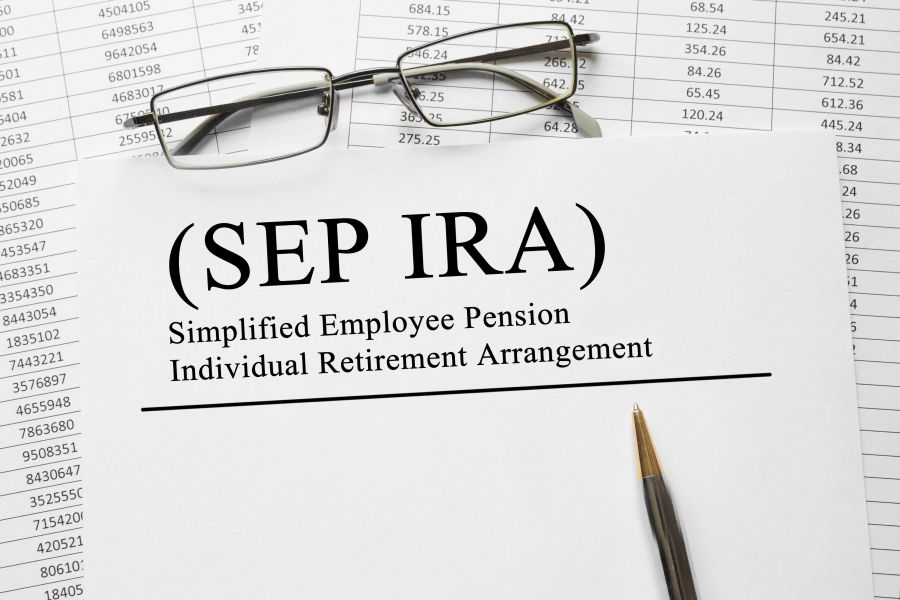An employer-sponsored 401(k) plan is one of the most common ways to start saving for retirement. In fact, for many employees, this is their sole retirement savings account.

It’s normal to have questions and concerns when it comes to saving for retirement. On that gets asked the most often is, “How much should you contribute to your 401(k)?”
Like most financial decisions, there are several things to consider. First, we’ll walk you through how you can figure out how much you should contribute to your 401(k). Then, we’ll show you some other types of accounts to consider.
How a 401(k) Works
A 401(k) is a retirement savings account sponsored by an employer. You typically make contributions directly from your earnings before receiving your paycheck, and taxes are taken out. However, once you start taking withdrawals during retirement, you’ll pay taxes on your savings.
Often, an employer offers a matching amount, usually based on a percentage of your annual salary. For example, your employer match may be 3%, and let’s say you make $60,000 a year.
If you contribute 3% of your salary ($1,800), your employer will contribute the same amount to your 401(k). So, it’s almost always a good idea to max out that employer match amount, whatever it may be. Essentially, it’s free money — why pass that up?
401(k) Contribution Limits
Contributing to your 401(k) comes with limits that adjust periodically. In 2025, the maximum employee contribution is $23,500, up from $23,000 in 2024. If you’re 50 or older, you can also make a catch-up contribution of $7,500. However, if you’re between 60 and 63, the SECURE 2.0 Act allows for a higher catch-up contribution of $11,250.
Even though you can contribute up to the limit, that doesn’t mean you should. Several factors come into play, including your current financial situation and how your contributions affect future taxes.
Since 401(k) contributions are made with pre-tax dollars, you’ll defer taxes on both your contributions and investment gains until you start making withdrawals in retirement. While this can be a benefit now, it’s important to consider how your tax bracket may change later and whether diversifying with a Roth IRA or other after-tax savings options might be a smarter move.
Analyze Your Current Finances
Once you’re contributing enough to your 401(k) to max out any employer contributions, take a step back and look at the rest of your finances. Most importantly, consider your current debt load. Be sure to pay off all high-interest debt before contributing more to your retirement account, whether it’s credit cards or loans.
You’ll save much more by avoiding paying all of that interest than what you’re likely to accumulate in your 401(k). Once you’ve taken care of that, it’s time to create an emergency fund if you don’t already have one. For short-term emergencies, it’s good to have a $1,000 emergency fund in an easily accessible account.
You should also consider saving a larger amount for a longer-term emergency, such as unemployment or going through an unexpected medical event. Experts often recommend having between three and six months of your expenses on hand for these types of situations.
Once you get your short and midterm savings on track, you can direct any extra income towards additional retirement accounts. But before you get aggressive with your retirement planning, make sure your current financial house is in good shape. A strong foundation is essential before building your retirement savings.
Estimate Your Retirement Needs
An intelligent way to think about your 401(k) contribution is to figure out how much money you expect to need once you retire. Many financial advisors recommend the 4% rule. That refers to withdrawing 4% of your total savings each year of retirement.
Let’s look at this theory with some example numbers.
If you have $1 million in savings, you should be able to withdraw 4% of that each year and have enough to last you through retirement. That comes to $40,000 a year. That may be enough to make ends meet for some people, and for others, it may be a stretch.
Play around with the numbers to figure out your savings goal. Then, pop some numbers into a retirement calculator to determine the annual amount you should be squirreling away. You can also experiment with how early you want to retire and how much you expect from Social Security.
Remember that you may not need the same amount of money you are living on now by the time you retire. It all depends on what you wish to do when you retire and what expenses you might have then. So take a holistic approach to saving and reducing expenses to determine exactly how much you’ll need.
Consider Opening an IRA
Once you figure out how much you would like to save each year to meet your retirement goals, think about all the available retirement account options. You definitely want to contribute to your 401(k) as much as your employer will match. That automatically adds a big chunk of cash to your portfolio without costing you a dime.
Beyond that, though, you should consider investing in an IRA. There are two types: a traditional and a Roth IRA. Like a 401(k), a traditional IRA allows you to invest with pre-tax dollars, saving the tax burden until withdrawal time comes.
Roth IRAs
A Roth IRA is funded with after-tax money, meaning you pay taxes on your contributions upfront, but your withdrawals in retirement are completely tax-free—including your earnings. This can be a great way to diversify your tax strategy, especially if you expect to be in a higher tax bracket later in life.
Beyond tax benefits, investing in a Roth IRA can also broaden your investment options. Unlike many employer-sponsored 401(k) plans with limited choices, an IRA allows you to invest in a wider range of stocks, bonds, and other assets.
There are contribution limits to keep in mind. For 2025, the annual IRA contribution limits are:
- Under age 50: $7,000 (unchanged from 2024)
- Age 50 or older: $8,000 (includes a $1,000 catch-up contribution)
If you’re working toward an annual retirement savings goal, consider allocating a portion of your contributions to a Roth IRA to maximize your long-term tax advantages.
How Taxes Affect Your 401(k) and Retirement Savings
We talked about the tax differences between 401(k)s, traditional IRAs, and Roth IRAs. So, why is it important to spread out your retirement savings?
Let’s walk through it.
Depending on where you are in your career journey, you may be making less or more than what you intend to withdraw each year during retirement. If you earn less money, it makes sense to contribute to taxable retirement accounts such as a 401(k) and traditional IRA because your tax rate will be lower.
Once you expect that you’re earning more than what you’d withdraw in retirement each year, consider putting more into a tax-deferred account like your Roth IRA. That’s because you’ll be taxed later on when you’re making a smaller amount of money.
It may seem complicated, but it’s great to start thinking about how you can maximize your tax advantages now and save on your future tax bill during retirement.
Increase Your Savings Goal
When figuring out your overall retirement contribution goal, some financial advisors recommend tucking away 10% to 15% of your income. Going back to that $60,000 annual income example, that comes to $6,000 to $9,000 each year, which you can spread out across your 401(k) and IRAs.
But once you get your debt under control and your liquid savings accounts padded, think about growing that percentage even greater. This is especially true if you’ve just started saving for retirement, relatively late in the game.
If you’re in your 30s or 40s, for example, you’re closer to retirement age than someone fresh out of college at 22. You’ve lost a few years of that compounded annual growth. Instead of worrying about how to build your nest egg, commit to saving as much as 20% to 25% of your income — or more if you can afford to. To stay on track, you may want to consider working with a financial advisor.
Bottom Line
There’s always a balance of living well now and preparing for an enjoyable future. Think of how you can bridge the gap between the two so that you’re not eating ramen every night for 20 years. Furthermore, plan how you’ll take care of yourself when you’re older so you don’t have to worry about it.
More and more Americans are working later to prepare for retirement. While that’s ok, make sure you put yourself in a position to make those decisions out of want rather than out of need.
Be sure to contribute enough to your 401(k) to get the maximum match from your employer. Additionally, you should diversify your retirement accounts to avoid high taxes in the future.




